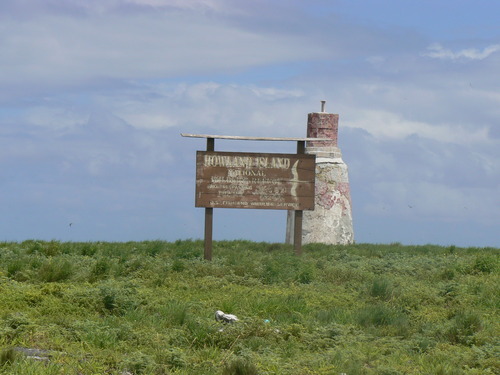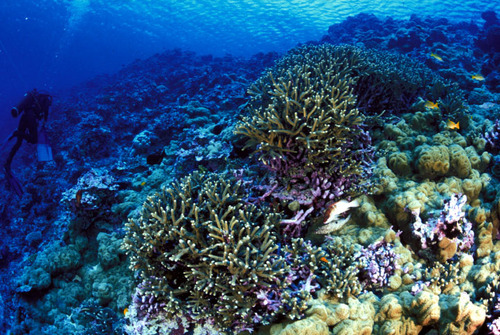Howland Island Refuge: Amelia Earhart and Guano Mining?

Amelia Earhart Beacon and Howland Island National Wildlife Refuge Sign. Credit: USFWS
By Shelby Eagan, Education and Outreach Intern- Kupu Americorp, Pacific Islands Refuges and Monuments Complex
In almost 80 years since the mysterious disappearance of Amelia Earhart, the history of her intended destination, Howland Island, is revealed. In 1937, Amelia Earhart and her navigation companion, Fred Noonan, prepared to journey around the world including one 2,556 mile leg across the South Pacific from New Guinea to Howland Island- a remote U.S. protectorate. Unfortunately, they never made it to their destination lost en route to the small, remote Pacific island. The 160-year history of Howland, located 50 miles north of the equator and 1600 miles southwest of Honolulu, and now in the protected waters of the Pacific Remote Islands Marine National Monument is indicative of Earhart’s odyssey: rich with tales of exploration, abundance, tragedy, and hope (Earhart, Amelia. Last flight. Random House LLC, 2009.)

The Amelia Earhart light beacon on Howland Island 1962. Credit: USFWS
Howland Island is teaming with wildlife and was declared a National Wildlife Refuge in 1974 under the jurisdiction of the U.S. Fish and Wildlife Service (USFWS). The diverse range of species inhabiting the atoll include 11 varieties of seabirds, 8 migratory shorebirds, 2 species of reptiles, a large population of land crabs, and a rich ocean life including abundant fish, Technicolor coral reef ecosystems, and marine mammals (USFWS A).
From 1850 to 1891, Howland Island was claimed by the United States under the “Guano Act” of 1856 by the American Guano Company. Guano is essentially bird droppings, which were used as fertilizer. It was brutally hot and hard work for miners earning pennies as they dug into the centuries of deposited bird guano, an estimated 85,000 to 100,000 tons, about the weight of a modern cruise ship, were removed from Howland Island, setting guano mining records of the time (USFWS A).

Frigate Birds and Masked Booby on Howland Island 2006. Credit: USFWS
Then, between 1935 and 1942, 130 brave young men were recruited first from Kamehameha Schools in Hawai’i and later other schools to establish residency and help the U.S. colonize Howland, Baker, and Jarvis Islands. These young colonists were essential to the United States’ success in securing the strategic territories in the Pacific, and chronicled their time on the islands in journals that have proven invaluable as both historical and biological records (Hui Panala’au). As Amelia Earhart planned her trip around the world with a stop at Howland Island, the U.S. Government began construction of a runway that would serve as a cross Pacific airway for flights from California to Australia (Hui Panala’au, USFWS A). The men on island prepared for her arrival by creating a fresh water shower and putting up curtains sent to them for her living space. Unfortunately, Earhart’s plane vanished at sea before arriving at Howland Island. Later, a memorial light beacon was constructed and dedicated to her in 1937 (USFWS A).
In 1941, tragedy struck the island again during World War II when 14 Japanese planes dropped approximately 60 bombs on Howland Island, killing two of the colonists. After the bombing, a Japanese submarine fired 50 shells into Itascatown, a small town left by the guano miners that the colonists erected for their permanent settlement, rendering the Amelia Earhart light beacon useless. On January 31st, 1941 53 days after the Japanese attack, the remaining colonists were transported off the island. Since then, for more than 70 years now, the island has remained un-inhabited by humans except for brief visits to restore the light beacon to add the two names of the lost colonists (Hui Panala’au, USFWS A), and for scientific study. In 1974, Howland, Baker, and Jarvis Islands were transferred to the U.S. Fish and Wildlife Service (USFWS) and were established as National Wildlife Refuges.

Acropora Spp. Staghorn Colonies Photo Credit: Maragos, USFWS
Scientific journeys by the USFWS, the National Oceanic and Atmospheric Administration (NOAA), and the U.S. Coast Guard have continued to embark to Howland, Baker, and Jarvis Island Refuges to study the biological diversity in both terrestrial and aquatic environments. The richness of the remote island supports a cornucopia of large and small organisms that rely on these protected waters for refuge.
The significant role that the Hui Panala’au, Amelia Earhart, and the guano miners played in the history of Howland Island Refuge will not be forgotten. The memory of their bravery, and her voyage across the ocean to Howland Island, which holds her light beacon today, will continue to live on through history.
References:
USFWS A Howland Island CCP
Earhart, Amelia. Last flight. Random House LLC, 2009.
Hui Panala’au: Hawaiian Colonists in the Pacific, 1935-1942, Univ. of Hawai’i at Manoa Ctr. for Oral History, Social Science Research Institute (2006).